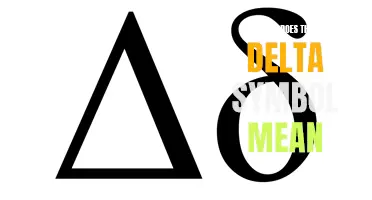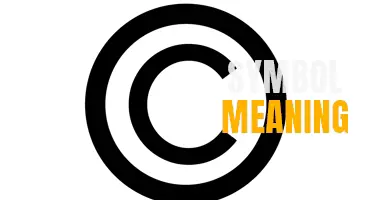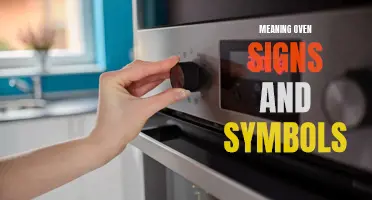
Dreidel, a beloved Jewish spinning top, is not just a fun game during Hanukkah. It is also infused with rich symbolism and meaning. From the Hebrew letters inscribed on its sides to the act of spinning itself, each element of the dreidel holds a deeper significance that connects generations and celebrates the triumph of a miraculous story. Join me as we delve into the fascinating world of dreidel symbols and meanings, illuminating the hidden secrets behind this cherished holiday tradition.
What You'll Learn
- What are the different symbols found on a dreidel and what do they represent?
- How do the symbols on a dreidel relate to the story of Hanukkah?
- Are there different variations of dreidel symbols and meanings depending on the region or tradition?
- Can you explain the significance and meaning behind each of the symbols on a dreidel?
- How do people use the symbols on a dreidel when playing the traditional Hanukkah game?

What are the different symbols found on a dreidel and what do they represent?
The dreidel is a traditional Jewish toy that is used during the holiday of Hanukkah. It is a spinning top with four sides, each containing a different Hebrew letter. These letters are nun, gimel, hey, and shin, and they have both a symbolic and practical meaning.
The nun symbolizes the Yiddish word "nisht," which means "nothing" in English. When the dreidel lands on this letter, nothing happens, and the player's turn ends.
The gimel represents the Yiddish word "gantz," which means "whole" in English. When the dreidel lands on this letter, the player takes the entire pot of tokens or goodies that have been collected.
The hey symbolizes the Yiddish word "halb," which means "half" in English. When the dreidel lands on this letter, the player takes half of the pot. This is often rounded up, so the player would receive one more token than half if there is an odd number.
The shin represents the Yiddish word "shtel," which means "put" in English. When the dreidel lands on this letter, the player must put one token or goodie into the pot.
These symbols and their meanings are not just part of a game, but also have a deeper significance. They represent the story of Hanukkah, which commemorates the rededication of the Second Temple in Jerusalem. During this time, the Jewish people were not allowed to openly practice their religion, so they would gather secretly to study the Torah. When the Greek soldiers would approach, the Jewish people would quickly hide their Torah scrolls and pretend to be playing with dreidels.
The dreidel became a symbol of resilience and faith during this challenging time. The nun represents the nothingness and emptiness that the Jewish people felt under Greek rule. The gimel represents the hope and joy that came with the rededication of the Temple. The hey represents the half-hearted compromises that some Jewish people made in order to avoid persecution. And the shin represents the courage and strength it took for the Jewish people to continue practicing their faith.
Today, the dreidel is still a popular symbol of Hanukkah and is often played with during the holiday. It is a reminder of the Jewish people's history and their ability to persevere in the face of adversity. It is also a fun and enjoyable game that brings families and friends together to celebrate the holiday. So next time you spin a dreidel, remember the significance of its symbols and the story it represents.
The Hidden Meanings Behind the NEDA Symbol
You may want to see also

How do the symbols on a dreidel relate to the story of Hanukkah?
The dreidel is a traditional spinning top that is associated with the Jewish holiday of Hanukkah. It is a popular game that is played during the holiday, and the symbols on the dreidel hold special significance to the story of Hanukkah.
Each side of the dreidel features a Hebrew letter - nun, gimel, hey, and shin. These letters represent the phrase "Nes Gadol Haya Sham," which translates to "a great miracle happened there." This phrase refers to the miracle of Hanukkah, when a small amount of oil lasted for eight days in the Temple after the Jewish Maccabees defeated the Greek army.
The letter nun stands for the word "nothing" in Hebrew. If the dreidel lands on this letter, the player does nothing and the turn passes to the next person.
The letter gimel stands for the word "everything" in Hebrew. If the dreidel lands on this letter, the player collects the entire pot of pennies or tokens.
The letter hey stands for the word "half" in Hebrew. If the dreidel lands on this letter, the player collects half of the pot.
The letter shin stands for the word "put in" or "add" in Hebrew. If the dreidel lands on this letter, the player adds a penny or token to the pot.
The game of dreidel is played by spinning the top and each player taking a turn. Depending on which letter the dreidel lands on, the player either collects or adds to the pot. The game continues until one player has collected all of the tokens or pennies.
The symbols on the dreidel, along with the game itself, serve as a reminder of the story of Hanukkah and the miracle that occurred during this holiday. It is a way for Jewish families and communities to come together and celebrate this important event in their history. Additionally, the dreidel game provides a fun and engaging activity for children and adults alike during the festival of Hanukkah.
The Intriguing Symbolism Behind the Triangle with Circle Inside
You may want to see also

Are there different variations of dreidel symbols and meanings depending on the region or tradition?
The dreidel is a traditional Jewish spinning top that is often played during the holiday of Hanukkah. It is a simple game that is enjoyed by both children and adults alike. However, depending on the region or tradition, there may be variations in the symbols used on the dreidel and their corresponding meanings.
The dreidel is a four-sided top with a different Hebrew letter on each side. The four letters are: Nun, Gimel, Hey, and Shin. In Israel, these letters stand for the saying "A great miracle happened here," referring to the miracle of the oil during the Hanukkah story. However, in some traditions outside of Israel, the letter Shin is replaced with the letter Pey, changing the saying to "A great miracle happened there."
The letter Nun stands for the Hebrew word "Nes," which means miracle. The letter Gimel stands for "Gadol," meaning great. The letter Hey stands for "Hayah," meaning happened. Lastly, the letter Shin or Pey stands for "Sham" or "Poh," meaning there or here respectively.
When playing the dreidel game, each player starts with an equal number of game pieces, such as chocolate coins or nuts. The players take turns spinning the dreidel and depending on which letter lands facing up, they follow the corresponding instructions. If the dreidel lands on Nun, the player does nothing. If it lands on Gimel, the player takes all the game pieces in the pot. If it lands on Hey, the player takes half of the pieces in the pot. Lastly, if it lands on Shin or Pey, the player must put one game piece in the pot.
While the symbols and meanings on the dreidel may vary depending on the region or tradition, the overall concept and enjoyment of the game remain the same. It is a fun way to engage in friendly competition and celebrate the miracle of Hanukkah. Whether the dreidel says "A great miracle happened here" or "A great miracle happened there," the spirit of the game and the holiday remains unchanged.
Unraveling the Deeper Significance Behind the Heart Symbol
You may want to see also

Can you explain the significance and meaning behind each of the symbols on a dreidel?
A dreidel is a traditional Jewish spinning top that is commonly played with during the holiday of Hanukkah. It features four Hebrew letters: נ (Nun), ג (Gimel), ה (Hey), and ש (Shin). These letters hold significant meaning and are an integral part of the game. Let's explore the significance and meaning behind each of the symbols on a dreidel.
נ (Nun):
The letter נ stands for the Hebrew word "Nes," which means "miracle." It represents the miracle that occurred during the events of Hanukkah. According to the Hanukkah story, a small amount of oil miraculously burned for eight days in the rededicated Second Temple in Jerusalem. The נ on the dreidel serves as a reminder of this miraculous event.
ג (Gimel):
The letter ג represents the Hebrew word "Gadol," which means "great." In the game of dreidel, if the top lands on ג, the player receives the entire pot of coins or treats. This symbolizes the victory that the Jewish people experienced during the Maccabean Revolt against the Greek armies. Despite being outnumbered and facing great odds, the Maccabees successfully reclaimed the Second Temple and established Jewish sovereignty in Judea.
ה (Hey):
The letter ה stands for the Hebrew word "Hayah," which means "it happened." This symbolizes the events and historical significance of Hanukkah. The Hanukkah story revolves around the rededication of the Second Temple and the victory of the Maccabees. The ה on the dreidel serves as a reminder of the historical context and the importance of remembering and celebrating this holiday.
ש (Shin):
The letter ש represents the Hebrew word "Sham," which means "there." In the game of dreidel, if the top lands on ש, the player adds a coin or treat to the pot. However, in Israel, the letter פֵּא (Pe) is used on dreidels instead of ש, which stands for the Hebrew word "Poh," meaning "here." The ש or פֵּא on the dreidel signifies that the spinner has to contribute something to the pot. The pot symbolizes the communal sharing of wealth and resources, highlighting the value of giving and generosity.
Together, these symbols on a dreidel connect the game to the story of Hanukkah, reminding players of the miracle, victory, historical significance, and the importance of giving. The dreidel game is a fun and educational way for people of all ages to celebrate and remember the events of Hanukkah, fostering a sense of unity and tradition within the Jewish community.
Unlocking the Mysteries: Understanding the Meanings of Protection Symbols
You may want to see also

How do people use the symbols on a dreidel when playing the traditional Hanukkah game?
The Dreidel is a traditional Hanukkah game that is played with a spinning top called a dreidel. The dreidel has four sides, each engraved with a different Hebrew letter: Nun, Gimel, Hey, and Shin. These letters are an acronym for the saying "nes gadol haya sham," which means "a great miracle happened there." In the game, players take turns spinning the dreidel and performing actions based on which letter the dreidel lands on.
Here is how people use the symbols on a dreidel when playing the traditional Hanukkah game:
- Nun: If the dreidel lands on the letter Nun, the player does nothing. The word Nun stands for "nisht" in Yiddish, which means "nothing." This means that the player neither wins nor loses any game tokens or coins.
- Gimel: If the dreidel lands on the letter Gimel, the player takes the entire pot. The word Gimel stands for "ganz" in Yiddish, which means "everything." This signifies that the player wins all the game tokens or coins that are in the center of the playing area.
- Hey: If the dreidel lands on the letter Hey, the player takes half of the pot. The word Hey stands for "halb" in Yiddish, which means "half." This means that the player wins half of the game tokens or coins in the pot.
- Shin: If the dreidel lands on the letter Shin, the player must put one game token or coin into the pot. The word Shin stands for "shtel" in Yiddish, which means "put." This signifies that the player has to contribute a game token or coin to the center of the playing area.
The game continues with each player taking turns spinning the dreidel until there is only one player with game tokens or coins left. This player is crowned the winner of the game.
The symbols on the dreidel and the actions associated with them add an element of excitement and unpredictability to the Hanukkah game. It is a way to commemorate the miracle of Hanukkah while engaging in friendly competition with friends and family. Whether you are a child or an adult, playing the dreidel game during Hanukkah is a cherished tradition that brings joy and laughter to all.
Exploring the Hidden Meanings of Dutch Symbols: Unearthing the Cultural Significance
You may want to see also
Frequently asked questions
- The four symbols on a dreidel are nun, gimel, hey, and shin. Nun stands for "nothing" in Hebrew, gimel stands for "all" or "everything," hey stands for "half," and shin stands for "putting in" or "addition." When playing the dreidel game, each symbol represents a different outcome or action.
- When spinning the dreidel during the game, if you land on nun, it means you do nothing and pass the dreidel to the next player. If you land on gimel, it means you get to take the entire pot of game pieces. If you land on hey, it means you get to take half of the pot. Finally, if you land on shin, it means you have to put one game piece into the pot.
- The nun symbol, which stands for "nothing" in Hebrew, represents a turn where nothing happens. When spinning the dreidel and landing on nun, the player simply passes the dreidel to the next person without gaining or losing any game pieces.
- The gimel symbol, which stands for "all" or "everything" in Hebrew, is the most desirable outcome when spinning the dreidel. When landing on gimel, the player gets to take the entire pot of game pieces, giving them a significant advantage in the game.
- The shin symbol on the dreidel is derived from the Yiddish word "shtel," meaning "put." In the context of the dreidel game, when a player lands on shin, they have to put one game piece into the pot. This symbol adds an element of chance and unpredictability to the game, as it can shift the balance of game pieces in the pot.







